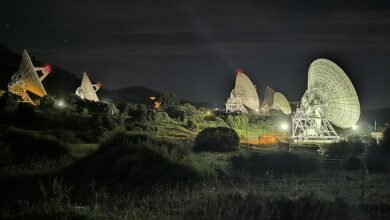
SpaceX’s Starship Rocket Reached Record Heights before It Was Lost
SpaceX lost both the booster and vehicle in a test launch of its massive Starship rocket. But the third try was the charm for Starship, which smoothly separated in its most successful flight to date

The SpaceX Starship spacecraft lifts off from Starbase in Boca Chica, Texas, on March 14, 2024.
Chandan Khanna/AFP via Getty Images
SOUTH PADRE ISLAND, Texas — SpaceX’s Starship megarocket, the world’s largest and most powerful rocket, reached orbital speed for the first time Thursday in a historic third test flight from South Texas.
Hundreds of Spring Break spectators, rocket launch chasers and SpaceX fans gathered along the southern shores of South Padre Island and surrounding areas to witness the third test flight of the biggest rocket ever built. About 5 miles (8 kilometers) south of the crowds, SpaceX’s massive Starship vehicle lifted off this morning (March 14) at 9:25 a.m. EDT (1325 GMT) from the company’s manufacturing and test launch facilities near Boca Chica Beach.
“Starship reached orbital velocity,” SpaceX founder Elon Musk announced on X (formerly Twitter) after liftoff. “Congratulations SpaceX team!!” The launch occurred on the 22nd anniversary of SpaceX’s founding in 2002, the company said.
On supporting science journalism
If you’re enjoying this article, consider supporting our award-winning journalism by subscribing. By purchasing a subscription you are helping to ensure the future of impactful stories about the discoveries and ideas shaping our world today.
Neither the Starship vehicle nor its Super Heavy booster survived all the way through to their intended splashdown, but SpaceX officials said the test flight achieved several of its key goals during the flight.
Cheers erupted from the South Padre crowd as the dim morning sky was illuminated by the ignition of Starship’s 33 first-stage Raptor engines, which quickly shrouded nearly the entire vehicle in a plume of dust and smoke. Seconds later, the 400-foot tall (122 meters) rocket rose from the plume, quickly increasing its climb skyward.
“This flight pretty much just started, but we’re farther than we’ve ever been before,” SpaceX spokesperson Dan Huot said just after liftoff in a livestream. “We’ve got a starship, not just in space, but on its coast phase into space.”
Today’s launch, designated Integrated Flight Test-3 (IFT-3), was the third test mission for the fully stacked Starship. The first and second Starship launches both ended explosively last year, with the vehicles detonating before the completion of each flight’s mission objectives. However, data collected during those first flights helped SpaceX engineers get Starship ready for success down the road.
Improvements made between IFT-1 and IFT-2 last year included the implementation of a “hot staging” technique, in which the upper stage engines begin firing before Starship’s first-stage booster, known as Super Heavy, fully separates. IFT-2’s hot staging maneuver was a success, as it was today as well.
High in the sky, Starship’s two stages separated about 2 minutes 45 seconds after liftoff, sending the 165-foot-tall (50 m) upper-stage spacecraft onward to space while Super Heavy began preparations for a boostback burn to redirect its trajectory. That post-staging burn reversed Super Heavy’s velocity, and was intended to be followed minutes later by a landing burn above the Gulf of Mexico. However, it appears the Super Heavy’s engines did not relight as planned, leading to the loss of the booster.
“It didn’t light all the engines that we expected and we did lose the booster,” Huot said. “We’ll have to go through the data to figure out exactly what happened, obviously.”
Starship is designed to be fully reusable, and SpaceX plans to land and relaunch its Super Heavy boosters, as it does with its Falcon 9 rockets. In the future, two “chopstick” arms on Starship’s launch tower will catch the Super Heavy booster as it returns for landing, but IFT-3’s Super Heavy was always expected to splash down in the Gulf.
Starship’s upper stage continued flying after separation, but didn’t attempt to go into a full orbit. Instead, the spacecraft entered a suborbital coast phase as it soared above Earth, during which SpaceX hoped to demonstrate two of the spacecraft’s flight systems toward vehicle qualification — the reignition of Starship’s Raptor engines and the transfer of cryogenic fuel between tanks. Following these demonstrations, the spacecraft was expected to splash down in the Indian Ocean about 65 minutes after launch, but SpaceX lost contact with the Ship during reentry.
“We are making the call now that we have lost Ship 28,” Huot said, referring to the Starship vehicle number, after an extended period without telemetry of contact with the vehicle. “We haven’t heard from the ship up until this point and so the team has made the call that Ship has been lost. So, no splashdown today.”
Rapid progress is needed for Starship, which is on the critical path for NASA’s Artemis 3 mission. Artemis 3 aims to land the first humans on the moon since the end of the Apollo era in the early 1970s. Artemis 3 is currently scheduled for 2026, giving Starship less than two years to meet NASA vehicle qualifications for landing astronauts on the lunar surface.
Copyright 2024 Space.com, a Future company. All rights reserved. This material may not be published, broadcast, rewritten or redistributed.







